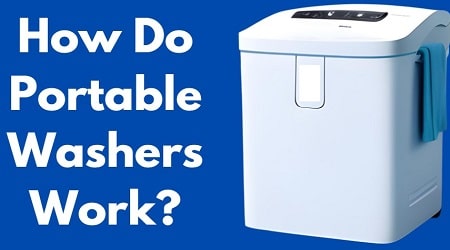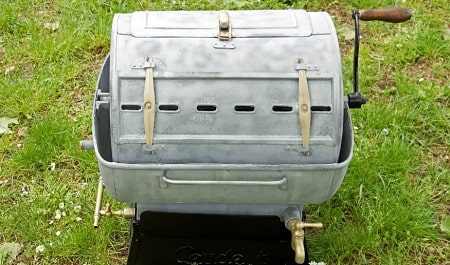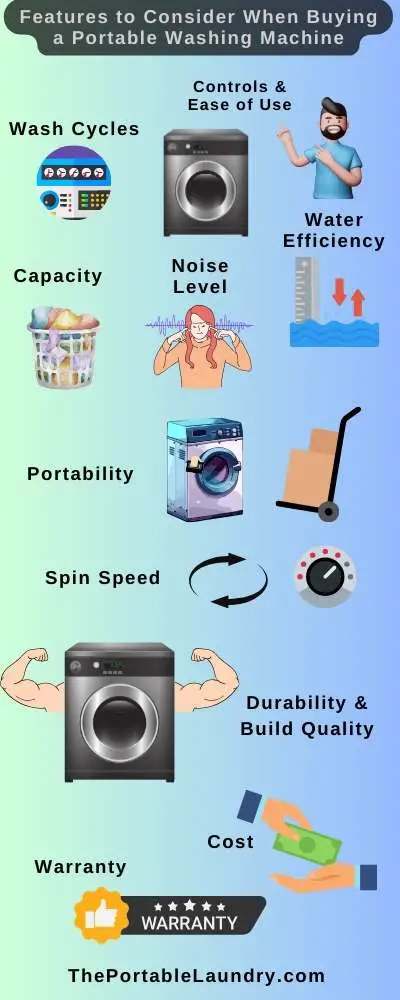In the realm of modern laundry solutions, portable washing machines have emerged as a space-efficient alternative to traditional washers.
Portable washers connect via inlet hose to faucets, pumping water into the tub with detergent and clothes. A rotating drum then agitates the clothes for cleaning. Once the wash cycle completes, the water is drained, and the clothes are spun dry. Ideal for small spaces and water/energy efficiency.
They are the perfect option for apartments, RVs, boats, and other locations with limited space since they provide a practical solution to manage laundry in small places.
But why would someone choose a portable washing machine and how do these tiny powerhouses work?
In this blog post, we’ll dive into the world of portable washers, exploring their working principles, benefits, and more.
Table of Contents
How Do Portable Washers Work?

The basic working principles of portable washing machines are similar to those of their full-sized counterparts.
While they are smaller in size, their core mechanism for cleaning clothes remains similar to that of regular washing machines.
Here’s a step-by-step breakdown of how these portable washers achieve the task of laundry while being compact and efficient:
Water Inlet and Agitation
Just like conventional washing machines, water is pumped into the portable washer through a designated water inlet.
The heart of the cleaning process lies in the agitating action of a rotating drum.
As the machine starts its cycle, the drum begins to move, creating a dynamic environment that facilitates the removal of dirt, stains, and odors from the clothes.
This agitation ensures a thorough and effective cleaning process.
Detergent Dispensation
To aid in the cleaning process, detergent is introduced into the water.
The detergent mixes with the water, forming a cleansing solution that penetrates the fabrics and lifts away dirt, grime, and various stains.
This step is crucial for achieving clean and fresh-smelling clothes.
Wash Cycle and Cleaning
The combination of water, detergent, and agitation sets the stage for the washing cycle.
As the drum continues to rotate, the clothes are repeatedly immersed and agitated in the soapy water.
This action helps break down and dislodge stubborn dirt particles and stains from the fabrics.
Water Drainage
Once the wash cycle is complete and the clothes are suitably clean, the water is drained from the machine.
A hose or similar drainage mechanism allows the used water to exit the machine, taking with it the accumulated dirt and detergent residue.
Spin Drying
After the wash, it’s time for the spin-drying phase.
The machine utilizes its spinner or drum to rapidly rotate the clothes.
This centrifugal force expels excess water from the garments, leaving them damp rather than dripping wet.
This step not only reduces drying time but also prepares the clothes for the next phase of laundry i.e., drying.
Note: Not all portable washers will have a spin-drying function. Check the user manual to confirm if your washer has the spin-drying function.
How do manual portable washers work? (working principle)

The portable washer working principle revolves around the fundamental concepts of washing, cleaning, and water circulation.
These machines consist of a drum or basin where you place your clothes.
To start the cleaning process, you manually add water, preferably warm, and a small amount of detergent into the drum.
Once the water and detergent are added, you initiate a cycle by turning a hand crank or manually agitating the clothes.
This motion helps agitate the clothes and dislodge dirt, stains, and grime.
Some manual portable washing machines feature a built-in agitator that mimics the action of traditional washing machines.
After the washing phase, the drum is emptied, and you need to manually refill it with clean water to rinse the clothes.
After rinsing, you drain the water from the drum, and the final step involves using the hand crank or a separate spinner mechanism to extract excess water from the clothes.
Benefits of Manual Portable Washing Machines
These compact devices offer several benefits, especially for those living in small spaces or without easy access to traditional laundry facilities.
They are convenient for travelers, campers, or those with limited living space.
Additionally, manual portable washing machines are cost-effective since they consume less water and energy compared to larger washing machines.
Disadvantages and Considerations
While manual portable washing machines have their advantages, they also have some drawbacks.
The manual labor required for washing, rinsing, and spinning might not be suitable for everyone.
Additionally, the washing process might not be as thorough as that of electric machines, especially for heavily soiled clothes.
Types of Portable Washing Machines
Portable washing machines come in a variety of types, each catering to specific needs and preferences, the primary types include:
Top-Loading Portable Washers
Similar to their traditional counterparts, top-loading portable washers are known for their ease of use and convenience.
They offer a simple loading mechanism, making them a popular choice for those who prefer familiarity with their laundry routine.
Portable twin tub washer
These types of washers have two compartments i.e., one for washing clothes with water and soap, and another for spinning clothes rapidly to remove excess water.
This separation allows you to wash and spin clothes at different times or in separate cycles, which is handy.
However, these features come with a higher price tag compared to other portable washers.
Front-Loading Portable Washers
Front-loading portable washers often prioritize efficiency and energy-saving.
These machines tend to use less water and detergent while delivering effective cleaning results.
Their horizontal drum design allows for gravity-assisted washing, requiring less mechanical agitation.
Features to Consider When Buying a Portable Washing Machine

When shopping for a portable washing machine, it’s essential to consider several key features:
Capacity
Assess your laundry needs and opt for a machine with an appropriate capacity.
Remember that portable washers generally have smaller capacities than full-sized machines.
Water Efficiency
Look for models that offer efficient water usage, given that many portable washers are designed to be environmentally conscious.
Noise Level
Consider the noise level of the machine, especially if you’re planning to use it in a small living space, some models prioritize quiet operation.
Wash Cycles
Check the available wash cycles, some machines offer a variety of cycles tailored to different fabric types and levels of dirtiness.
This can be especially handy for maintaining your clothes’ longevity.
Controls and Ease of Use
Consider how user-friendly the machine is.
Are the controls straightforward and intuitive? A machine with easy controls will make your laundry routine much smoother.
Portability
Since we’re talking about portable machines, the level of portability matters.
Some models have built-in handles, while others might be more compact for easy transport and storage.
Spin Speed
The spin speed determines how dry your clothes will be after washing, a higher spin speed means less drying time afterward.
Durability and Build
You surely want your washer to last through numerous cycles.
Read reviews and look for models with good reputations for longevity.
Price
Of course, your budget matters.
Price is an important factor to consider, while portable washers are generally more affordable than full-sized machines, prices can still vary.
Find a balance between features and cost that works for you.
Warranty
Check if the machine comes with an extended warranty.
This provides you with peace of mind, knowing that you’re covered in case of any issues.
By considering these features, you’ll be well-equipped to make an informed decision when buying a portable washing machine.
Hooking Up a Portable Washer: Simple Steps for Setup
When setting up a portable washer, there are several key steps to ensure a smooth hookup process.
- First, find a suitable location close to a water inlet and a drain, this can be a sink, a bathtub, or a dedicated water source.
- Next, connect the water inlet hose to the water source. Make sure it’s securely attached to prevent leaks.
- Insert the other end of the hose into the designated water inlet on the machine.
- If your portable washer has a water outlet hose, connect it to the drain, ensuring proper positioning to facilitate smooth water flow.
For electric models, plug the machine into a power outlet.
Some models might require grounding for safety purposes, so check the manufacturer’s instructions.
If the machine has a control panel, power it on and follow the prompts to choose the desired wash settings.
Load your clothes into the drum according to the manufacturer’s guidelines, ensuring not overload it.
Finally, close the lid securely and initiate the washing cycle.
Remember, each portable washer might have specific setup requirements, so referring to the user manual is crucial for a successful hookup.
Also Read: How to Hook Up Portable Washing Machine?
Portable washing machine usage tips
Using a portable washer effectively requires some understanding of its unique features. Here are a few tips to make the most of your machine:
- Sort Your Laundry: Just like with traditional washing machines, sorting your laundry based on colors, fabric types, and levels of soiling can optimize cleaning results. This ensures that delicate fabrics won’t be subjected to the same level of agitation as sturdier ones, and prevents color bleeding.
- Choose the Right Cycle: Portable washing machines often offer different washing cycles. Selecting the appropriate cycle based on the type of fabric and the level of dirt can improve the cleaning efficiency while being gentle on your clothes.
- Optimal Water Temperature: Some portable washers allow you to control the water temperature. For whites and heavily soiled items, using warmer water can enhance the cleaning process. However, always refer to garment care labels to avoid damaging sensitive fabrics.
- Regular Maintenance: Clean the drum and other components of your portable washer regularly to prevent the buildup of detergent residue and mold. Wipe down the interior and leave the door open between cycles to allow air circulation.
- Avoid Tangling: Delicate fabrics, such as lace or sheer items, can become tangled during the wash cycle. Placing them inside a mesh laundry bag can help prevent snags and tears.
- Preserve Zippers and Buttons: Turn clothes with zippers or buttons inside out before washing. This prevents them from snagging on other items and potentially damaging both the clothes and the machine.
- Use Proper Water Levels: Be mindful of the water level you add to the machine. Too much water can result in inadequate cleaning, while too little can hinder agitation.
- Loading and Unloading: Avoid overloading the machine, as it can affect cleaning efficiency. Follow the manufacturer’s guidelines for the optimal load size.
- Adding Detergent: Use an appropriate amount of detergent for the load size. Many portable washers have designated detergent dispensers or guidelines for measuring detergent.
- Draining Water: Ensure the drainage hose is properly positioned to allow water to flow out freely. Use the machine’s drainage system to empty the water tank after each cycle.
Wrap Up
From their space-saving designs to their cost-effective operation, portable washers have earned their place as essential tools in today’s dynamic living environments.
The advantages they bring, from easy transport and affordability to compatibility with various lifestyles, have made them a popular choice for those seeking flexible and efficient laundry solutions.
However, as with any innovation, portable washers do come with their own set of limitations.
Their smaller capacities, potential cleaning limitations, and occasional operational noise should be weighed against their conveniences.
By understanding both the strengths and challenges of portable washers, you can make an informed decision that aligns with your unique laundry requirements.
You May Also Like
- Portable Washer Energy Consumption: Save up to 50%
- Haier Portable Washing Machine: 18 Commonly Asked Questions
- What is a Portable Handy Bucket Washing Machine Device?
- Portable Washing Machine: 10 Common problems & Solutions
- Does LG make portable washing machines?
- How to use a portable washing machine effectively?
- Portable Washing Machine: Can It Use Regular Hookups?
- 14 Things you shouldn’t wash in your portable washer
- The Ultimate Guide to troubleshoot Portable Washing Machine Issues
- How to Clean Portable Washing Machine? (Easy Guide)
- Ultrasonic Portable Washer: Everything You Need to Know!

